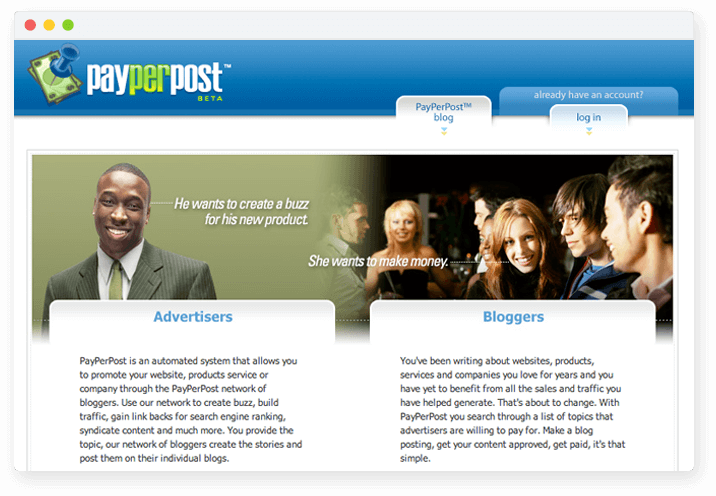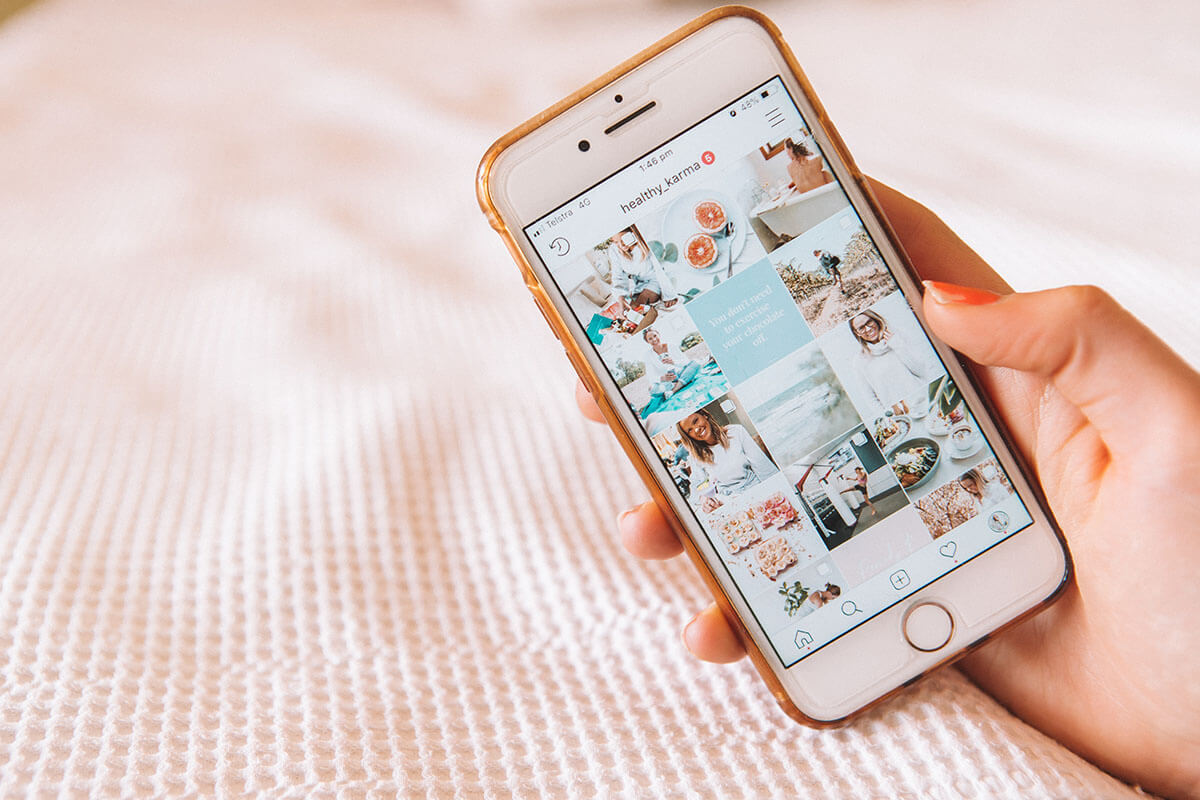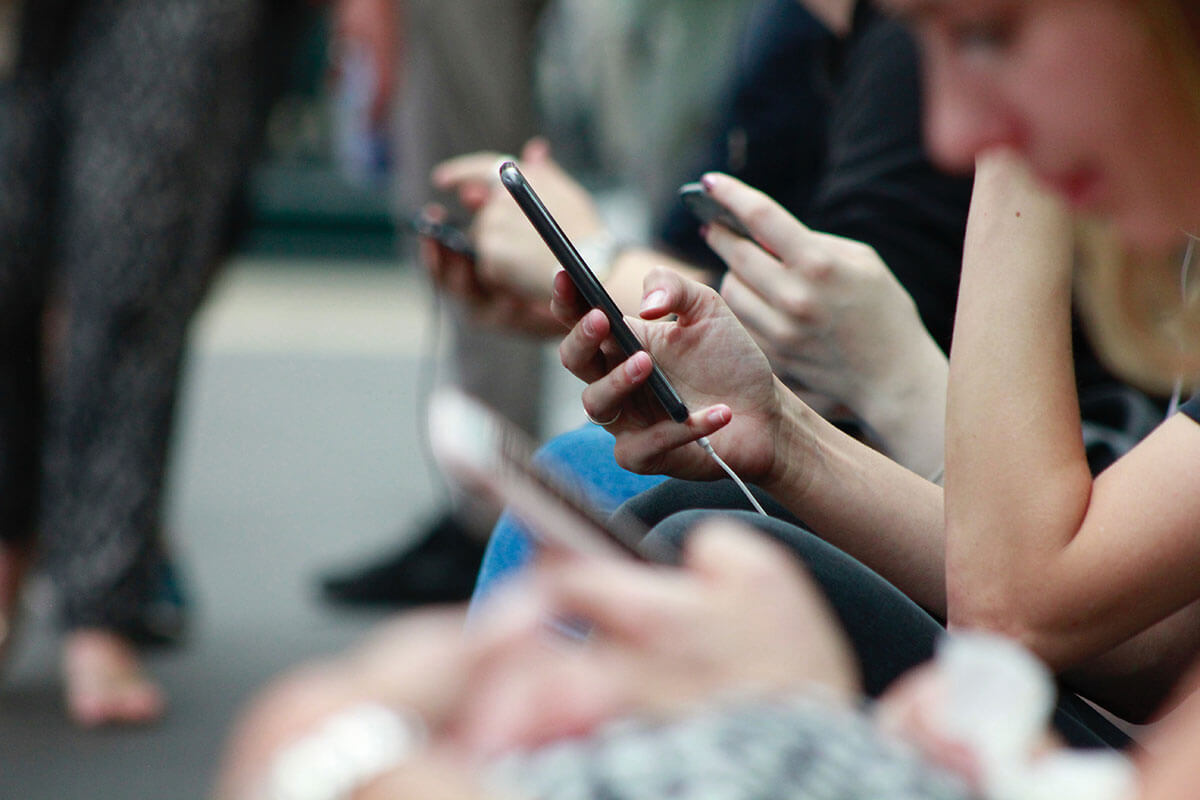
In this guide you will learn how to become an influencer, what brands are looking for and how much you could make.
Influencers
In this guide you will learn how to become an influencer, what brands are looking for and how much you could make.

Imagine this: Your old running shoes have finally fallen apart, and now you’re in the market for new sneakers. You might start your search online, but the Internet offers enough options to overwhelm the average consumer.
Then, on Twitter, you notice a local fitness coach tweet out an endorsement of her new pair of shoes. She links to a blog post, where she breaks down all of the shoes’ cool features. You start to think, “Hey, I should give these running shoes a try!”
This is influencer marketing in action.
So, what are influencers? An influencer is anyone who the public perceives as a trustworthy voice in a specific niche. Influencers use their knowledge and platforms to guide consumers towards certain goods and services. They’re digital trendsetters, and brands love to have influencers on their side.
How influential are influencers? In 2016, research by Twitter revealed that about 40 percent of its users bought an item after seeing an influencer’s endorsement. Overall, users see influencers as being nearly as trustworthy as actual friends

Types of Influencers
Although influencers tend to be respected voices in their niches, they don’t all share the same credentials. That fitness coach who talked you into buying your new shoes is an industry expert. No matter her level of fame, she likely has the knowledge and experience to judge workout attire and equipment. On the other hand, some influencers command more attention than they do expertise.
Classic Celebrity Influence
Almost everyone is familiar with celebrity endorsements. In the past, Alfred Hitchcock promoted Western Union and Oprah Winfrey promoted Weight Watchers. These are classic examples, but even in the modern age of marketing celebrities continue to endorse brands via social media and other platforms. Celebrities like Selena Gomez, Dwayne “The Rock” Johnson and Beyoncé Knowles can make thousands of dollars just for posting about a brand on Instagram.
Online Stars
Not all celebrities are from the television or big screen. Social media stars are famous for their informative or entertaining online content, and they often use that digital fame to promote brands.
For example, if you only watched cable television, you might not know Mark Fischbach, AKA Markiplier. But this gamer has a YouTube audience of over 20 million followers. On occasion, he uses his influence to endorse brands that he genuinely likes, such as the Bellagio resort in Las Vegas.
Audience Size
While Markiplier has millions of followers, not all influencers enjoy this level of popularity. Influencers fit into four tiers: mega, macro, micro and nano.
The most famous individuals are mega influencers. They tend to have over a million followers and have online and offline fame. Think Beyoncé and Kim Kardashian West.
On the other end of the spectrum, nano-influencers might only have audiences of 1,000 followers. However, their ability to genuinely connect to ordinary consumers can make them a very effective part of a brand’s marketing strategy.
No matter the size of an influencer’s audience, he or she can be a useful ally for a business looking to attract more customers. Few things are more valuable than a genuine and well-articulated testimonial.
For online marketers, influencer-driven marketing is a popular and effective strategy for increasing sales and spreading brand awareness. Although the concept of influencer endorsements might have some similarities to celebrity brand endorsements, influencer marketing is fairly new by comparison.
Influencer Marketing Origins
Let’s trace the use of this marketing strategy back to 2004. Independent content creators were gaining prominence in the digital public square. Consumers trusted these creative individuals to guide them toward the most useful and reliable goods and services — hence the name, influencers.
Ted Murphy — the eventual founder of IZEA — took note of these influencers and started a practice called eSeeding. The eSeeding group arranged for influencers to endorse certain brands, and, in return, the influencers would often receive compensation in the form of gift cards.
By 2005, Murphy had compiled a database of influential bloggers, and he helped connect them to receptive advertisers. It was an innovative strategy that would change the world of online marketing.

The Industry Grows
The following year, PayPerPost debuted. This marketplace guided even more bloggers to businesses that were looking to increase their online traffic and sales. PayPerPost would later become IZEA, and plenty of competitors cropped up, following similar marketing models. The industry took off, with Murphy often advocating for transparency from brands and their associated bloggers.
By 2010, even social networks were beginning to allow advertisers to use promoted posts to pull in money. But brands weren’t the only ones benefiting from this emerging industry. Micro-influencers — people who draw smaller audiences than standard influencers — also found success, thanks to new platforms like WeReward.
Today, influencer marketing has grown into an effective and indispensable tool for many brands. Over 60 percent of marketers plan on spending more money on their influencer campaigns in 2019, according to BigCommerce. Businesses have noted the power of influencers, and they plan on riding that marketing wave into the future.
Most Recent
Have you heard of the toddler who makes $1 million a month on YouTube as an influencer who tests toys? Many other highly paid influencers have become semi-household names, but mostly for their shock value.
Online platforms provide plenty of room for influencers of all ages to turn their passions into moneymaking ventures. Even if you’re a nano-influencer with fewer than 1,000 followers, you can make money too. Here’s how much influencers of all statures can make.
Celebrity influencers
Super celebrity Kim Kardashian can command anywhere from $250,000 to well over $500,000 per post if a company wants her audience to see its products.
Macro-influencers
For every 1 million followers, an influencer can rake in about $10,000 per post. Another way to look at it is one cent per follower, or $100 per 10,000 followers.
However, there are many factors that go into the rate for a campaign marketing plan, such as what platform you’re using and your engagement rate. YouTube pulls in the most money. If you’re an influencer with well over 1 million followers on YouTube, you might earn $100,000 to $250,000 per video.
Micro-influencers
With between 1,000 and 10,000 followers, micro-influencers command plenty of trust with their audiences. That means a micro-influencer is also highly desirable to a company that has an influencer marketing program. If you have between 5,000 to 10,000 followers, you might earn between $100 to $500 per post.
Nano-influencers
With fewer than 1,000 followers, nano-influencers can promote a brand in exchange for one of that brand’s products. If you prefer payment, you’ll have to contend with less than $100 for a post. If you’re in an uncrowded, but highly desirable niche for a brand, you might make a little more.
Although it might seem like there’s a science to the influencer pay scale, it’s still the Wild West out there. You won’t find a set standard. Influencers have plenty of other variables to consider when deciding how much a post or campaign is worth.
- Platform: Depending on the kind of campaign you and your client are running, payment may depend on the platform you’re using to promote the product. YouTube is the highest paying platform with reported payments of about $1,000 per 100,000 followers. Instagram follows with potential payments of $1,000 per 100,000 followers. If you’re running a campaign on multiple platforms, the rates you charge might be a little more complicated.
- Campaign: A campaign can greatly vary in length and engagement needs, which affects how much an influencer can charge.
But making money as an influencer is not all about campaigns and sponsored posts. Here are some other ways influencers of all sizes are making money today:
- Physical product creation and ecommerce
- Podcast subscriptions
- Webinars
- Public appearances (for brands) as a brand ambassador
- Affiliate marketing and Amazon’s Influencer Program
Essentially, when you’re an influencer who wants to monetize your expertise and audience, consider yourself a small business. But it’s a business you can have fun starting as a side gig. And if you’re professional, consistent and persistent, you might even make a living doing it.
Most Popular
Becoming an influencer is the new “it” job to have, and it’ll be a long time before that changes. Many social media stars ambled into the early influencer fray because they began posting their passions on Instagram. Others took a more decided approach and targeted a need until it snowballed into a moneymaking venture. The influencer arena changes almost daily, and what it took to become an influencer even a year ago differs from today.
What did it take to become noticed in the early days of influencers? It took grit and a focus on one platform. How do you become an influencer now? It still takes grit, and you have to spread your efforts on multiple platforms.
The term ‘influencer” is actually quite old, dating back to the days of fashion icon Coco Channel and earlier. Then the popularity of celebrity endorsements emerged in the 1980s and 1990s. When Instagram launched in 2010, viewers flocked to bloggers and brands using the platform. In 2018, the influencer world exploded with increased marketing budgets and increased pressures on both influencers and brands. Today, the industry continues to evolve, including the ways to becoming an influencer. The general path remains the same, but with a few significant additional steps:

Your Niche
Find a niche that you’re passionate about or have an expertise in, and focus, focus, focus. It doesn’t matter how many other influencers are in the same niche. If you have a genuine love for the subject, it’ll come through in your posts.
Your Bio
To attract followers, know your topic. Or, be honest and say you’re learning and invite others to learn along with you. Your bio is the beginning of your branding. Study your favorite influencer’s bio and figure out why it’s compelling.
Your Platforms
It’s not just about Instagram anymore, though it’s estimated to have 1 billion active monthly users. There are plenty of influencers on Twitter, which may have more engagement with followers than Instagram. YouTube is extremely influential with an estimated 1.9 billion active monthly users per month. The key today is to distribute content on all or at least two platforms to capture followers.
Your Stories
Instagram has evolved beyond just photos. Now, you need to put some meat behind those eye-catching images in the form of stories. Through your real stories, you’ll begin to engage with your audience and connect with your followers.
Your Feed
It needs to be consistent, coherent, and with an authentic style all your own. Use editing tools and filters to stand out in a way that blends with your content and niche. It’s almost like putting a beautiful book together. Take your time and be thoughtful with your content and your image.
Your Followers
They need to be real, not fake, so forget about buying them. Fake followers don’t engage, and real followers can sniff that out.
Your Designation
You no longer need to be designated as a mega-influencer to get noticed. Brands, and audiences, are beginning to pay attention to nano-influencers (less than 1K followers) and micro-influencers (1K to 100K followers). Influencers with smaller audiences have hyper dedicated captive audiences, which is ideal for brands. In fact, according to Forbes.com, marketers want to partner with smaller, edgier and more controversial influencers that have zealous followers.
Your Favorite Brands
It pays to reach out to a company or brand that you truly believe in, tell them you’re just getting started and ask the marketing person from the bottom of your heart for a sample for a photo. You never know where it could lead from there, maybe even a long-term partnership.
Your Networks
Last and by no means least, join and apply to influencer networks. Networks act like agents, matching brands and their budgets to influencers. As you grow, consider joining Amazon’s influencer program which rolled out in 2017. It’s a richer version of its successful affiliate program, but allows influencers a free storefront filled with recommended products and a way to make money.
If you’re hoping to be an overnight influencer, it could happen. There are stories of influencers who took two months to become a moneymaking brand ambassador. In the influencer world, miracles have been known to happen.
Where do new brands turn to when they’re launching? Where do established brands go when looking for exposure to a new audience? Enter influencer marketing. Influencer marketing bypasses traditional routes and print advertising for relationships with social media powerhouses who drive brand awareness through a targeted campaign aimed at their captive audiences. That all sounds good, but what exactly are brands looking for from influencers? As an influencer, you’re expected to demonstrate and provide value to the brand before, during and after a campaign. Here’s how you can do just that.
Before the Campaign: Prove Your Metrics
As a professional influencer, you already know your demographics. You’ll also want to be able to present performance metrics to an interested brand. That no longer means how many followers you presently have for numerous reasons such as fake followers and the rise of nano-influencers. Marketing is a business, so if you’re an influencer hoping to make a living as a social media star, you’ll need to understand and drill down into your core engagement metrics, for example:
- Organic follower growth analysis
- Reads
- Shares
- Unique and direct clicks
- Reach
- Reactions
- Time spent on site/page
These are some of the analytics a brand needs to know before investing time and money into your expertise. They want to know you’re able to drive traffic and sales of their brand. There are plenty of analytics tools. Luckily, if Instagram is your dominant platform, you can take advantage of Instagram Insights. But you’ll need to be able to adequately interpret those insights.
Before the Campaign: Prove Your Relevance
A marketer will seek out an influencer whose content is relevant to the brand needing exposure. But as an influencer, you’ll also feel motivated enough to work with the brand because you feel an organic alignment. You may receive up to 20 brand pitches on a weekly basis, but you’ll need to realistically vet these opportunities. If there’s no relevance between you and the brand, the entire campaign will feel forced and deceptive, resulting in damage to both your reputation and the brand’s. As an influencer, take note on an in-depth Crowdtap survey of 50 creators:
- 44 percent choose to work with a brand because it’s relevant to the influencer’s audience
- 17 percent choose to work with a brand because it’ll give them an exclusive influencer experience
- 14 percent choose to work with a brand because they simply like it
- 10 percent work with a brand because it’ll help promote the influencer
- 8 percent only take on a brand because they have an expertise in the subject area
Focusing on working with a brand because it’s relevant to your audience — and also, because you like it — will likely result in a successful campaign.
During the Campaign: Prove You’re a Team Player
Proving you’re a team player should never mean selling out to any brand, company or marketer. What it does mean is you’ll have to walk the fine line of staying authentic and creative while maintaining an effective strategic relationship with your partnered brand with appropriate influencer-generated content. A brand chooses you because you have influence over your audience, but they need to trust you’ll also give them what they need: a return on their investment. For example, you may want to offer a promotion or time-sensitive discount on a brand that’s exclusive to your audience as a way to funnel followers and convert them to sales, making everyone happy in the process.
After the Campaign: Prove You’re in It for the Long-Term
Brands don’t appreciate partnering with an influencer who has highly limiting or strict editorial guidelines. That’ll squash any possibility of a long-term partnership. If you hit a few bumps in the road during your campaign, evaluate the experience and the process with a post-implementation review with insights from your perspective. Share your results with the brand and ask if they have any campaign results they’re willing share. A mutual, professional recap goes a long way towards building solid bridges for the future.
Brands love to hire influencers to be part of their marketing dream teams. But why? What do you, as an influencer, offer that an old traditional print ad doesn’t? Connections.
You’re worth your weight in gold because you have an audience of followers who trust your opinions. Brands hire influencers because the public sees influencers as trustworthy sources of information. Eighty-four percent of marketers who’ve used influencers believe the strategy is effective for their brand, according to Social Media Today. Here are more six more reasons why brands hire influencers:
 Influencers are Content Machines
Influencers are Content Machines
Building up a brand’s blog takes time, effort and employees to do the job. A company’s blog is just that, a company’s blog. But you offer oodles of consistent, creative and engaging content that captures your followers’ attention spans.
Influencers are Experts on Their Topic
It’s why you became an influencer in the first place. You had a passion or expertise on a topic and ran with it on social media. It just so happens that others love to listen to your informative and authentic messages.
Influencers Build Relationships
Brands know that an influencer is more like a peer than an authority figure to followers. Your voice sounds more like a good friend giving another friend advice or a recommendation about a brand. Friends also engage and interact.
Brands prefer working with influencers who have high engagement rates. That’s even more important than your number of followers. It’s also great news for micro- and nano-influencers. A survey published in Social Media Today reports that micro-influencers can have seven times more engagement with followers than influencers with much larger followings.
Influencers Know How to Communicate
Though influencers and followers can be of any age, the sweet spot for Instagram seems to be between 18- to 34-years old. That means both you and your followers have grown up using social media and digital products.
You know what it takes to communicate well on digital platforms. You may have a sense of humor or an effective writing style. Maybe you simply shine on camera. Whatever way you communicate, it works for your audience, and brands want to tap into that magic.
A traditional branded advertising program can be a hit or miss proposition. When a brand uses the right influencer, it’s more hit than miss.
Influencers Show Off Brands
Influencers excel at building brand awareness. You use your creativity to show off a brand to your followers. And those followers love to learn all about your favorite products.
Your style is more exciting than an ad. It’s more creative than a press release. And it’s more relatable than an article intended for a mass readership.
Influencers Drive Traffic and Sales
As an influencer, you know that once you start the conversation about a brand, the momentum keeps going. Your efforts should result in traffic and sales.
Your followers see you interacting with a brand, and now they’re thinking about that brand and how to incorporate those products into their own lives. Brands love working with influencers who know how to achieve the marketing benchmarks of organically funneling followers and converting them into leads or sales.
Brands know that influencers have an enormous amount of talent that’ll bolster a marketing plan. When the stars align, an influencer marketing plan can be a wildly successful collaboration for both you and the brand.


 Influencers are Content Machines
Influencers are Content Machines
Recent Posts / View All Posts